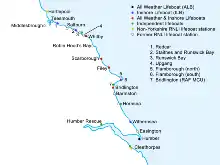Teesmouth Lifeboat Station
Teesmouth Lifeboat Station was a Royal National Lifeboat Institution (RNLI) lifeboat station, situated on the mouth of the River Tees, South Gare, North Yorkshire, England. The lifeboat station had been operating at Teesmouth for 177 years when it was closed by the RNLI in 2006. The withdrawal of the lifeboat capability from Teesmouth was subject to much criticism from the local council and the volunteers who crewed the boat, but the RNLI stated that there was an over-provision of lifeboat cover on the north-east coast.
| Teesmouth Lifeboat Station | |
|---|---|
 | |
 The former Lifeboat Station at Teesmouth | |

| |
| General information | |
| Type | RNLI Lifeboat Station |
| Location | South Gare, North Yorkshire |
| Country | England |
| Coordinates | 54.6403°N 1.1405°W |
| Closed | 2006 |
| Demolished | 2010 |
| Owner | Royal National Lifeboat Institution |
The former lifeboat house was demolished in 2010, four years after the station had closed.
History
A lifeboat was based at Teesmouth in 1829, which was 30 years before the South Gare breakwater was built, so the location was slightly further seaward than the latter day lifeboat station.[1] The boat allocated to Teesmouth was one of the type developed by George Palmer, who recognised the need for a self-righting boat and so added extra buoyancy.[2] A lifeboat house was not provided until the Tees Bay Lifeboat and Shipwreck Society sourced one in 1843. In 1911, the RNLI provided a new lifeboat in response to the mounting number of shipwrecks on the east coast. This needed to be somewhere that a lifeboat could be launched and recovered no matter the weather or tide state and the new location of Teesmouth fitted the bill perfectly.[3] The 1911 lifeboat was moored afloat until a new lifeboathouse was provided in 1914. This stayed as the main lifeboathouse until 2006 (with additional crew facilities added in 2002).[4]
The South Gare Breakwater was completed in 1888 using slag transported from the steel and iron blast furnaces at Cargo Fleet (Middlesbrough) on the south side of the River Tees.[5] To get the slag to the breakwater, a railway was built for ease of use. The truncated railway later became a leisure activity from which local people and tourists could take advantage of by using a sail bogey (a wagon powered by sails) to take a trip to the end of the breakwater.[6] In the early days of sail bogey use on the line, the lifeboatmen used it to get to their lifeboathouse quickly when they were on a call-out. After it became derelict and out-of-use, the lifeboatmen used to gather in Redcar and take a bus to Teesmouth Lifeboat Station, which would cause traffic problems in Redcar.[7]

After a two-year review of lifeboat cover in the United Kingdom, the RNLI decided to close Teesmouth as there was an All-Weather Lifeboat (ALB) stationed at Hartlepool, only 4 miles (6.4 km) away. Additionally, along where the Teesmouth Lifeboat operated, there were eight lifeboat stations along a 25-mile (40 km) stretch of coast.[8] After the closure notice came, Redcar and Cleveland Council petitioned the RNLI to keep the station open for another year after an offer of free moorings came from a local port operator.[9]
One of the key arguments about the Teesmouth Lifeboat, was that it could always launch whatever the weather (its slipway being located in 46 feet (14 m) of water and upstream of the mouth of the River Tees).[10] This was borne out in October 1951 and November 1966, when the Teesmouth boat was launched to effect a rescue from SS Pandora and Neptune 1 after the Redcar, Runswick Bay and Whitby lifeboats were unable to launch in the bad weather.[8]
At the end of April 2006, the lifeboat Phil Mead, left Teesmouth to join the RNLI's reserve fleet at Amble.[11]
Notable incidents
- 30 October 1914 - The Teesmouth boat, along with five others from the east coast (Upgang, Whitby, Scarborough and Tyne) helped to rescue 145 people from the shipwrecked SS Rohilla just south of Whitby Harbour.[12]
Fleet
| Dates in service | Class | ON | Op. No. | Name | Comments |
|---|---|---|---|---|---|
| 1911–1917 | Bradford | [13] | |||
| 1917–1924 | 687 | Ethel Day Cardwell | [14] | ||
| 1924–1950 | 45ft Watson-class | 647 | J W Archer | The J W Archer carried sails in case of breakdown.[15][16] | |
| 1950–1960 | 46ft 9in Watson-class | 868 | John and Lucy Cordingley | [17] | |
| 1960–1986 | 47ft Watson-class | 953 | Sarah Jane and James Season | [18] | |
| 1986–2006 | Tyne-class | 1110 | 47-008 | Phil Mead | [8] |
References
- Leach 2018, p. 106.
- Leach 2018, p. 19.
- Sampson, Lindsey (24 January 2015). "Perfectly sited to save seafarers". Evening Gazette. ProQuest 1647782631.
- Leach 2018, pp. 106–107.
- Philo, Phil (1993). Redcar: A Pictorial History. Chichester: Phillimore. 3. ISBN 0-85033-864-6.
- Philo, Phil (1993). Redcar: A Pictorial History. Chichester: Phillimore. 6. ISBN 0-85033-864-6.
- Chrystal 2012, p. 34.
- "The story of our lifeboat heroes". Gazette Live. 4 February 2006. Retrieved 20 February 2019.
- "Give us one more year - Last bid to keep lifeboat station open". Gazette Live. 20 April 2006. Retrieved 20 February 2019.
- "Final bid to save lifeboat base". BBC News. 11 April 2006. Retrieved 20 February 2019.
- Ruane, Michelle (19 October 2006). "Staying Afloat". Evening Gazette. ProQuest 351098091.
- "Centutenary[sic] to be marked". Whitby Gazette. 30 April 2014. ProQuest 1519781843.
- "Lifeboat 2". www.teesmouthlifeboat.org.uk. Retrieved 21 February 2019.
- Leach 2018, p. 107.
- Philo, Phil (1993). Redcar: A Pictorial History. Chichester: Phillimore. 10. ISBN 0-85033-864-6.
- Robson, Dave (1 October 2010). "Delight as former lifeboat returns to Teesside". Gazette Live. Retrieved 20 February 2019.
- Leach 2018, p. 43.
- "Lifeboat 3". www.teesmouthlifeboat.org.uk. Retrieved 8 March 2019.
Sources
- Chrystal, Paul (2012). Lifeboat Stations of North East England; From Sunderland to The Humber, Through Time. Stroud: Amberley. ISBN 978-1-4456-1376-5.
- Leach, Nicholas (2018). The Lifeboat Service in England; the North East Coast, Station by Station. Stroud: Amberley. ISBN 978-1-4456-6832-1.
- Philo, Phil (1993). Redcar: A Pictorial History. Chichester: Phillimore. ISBN 0-85033-864-6.